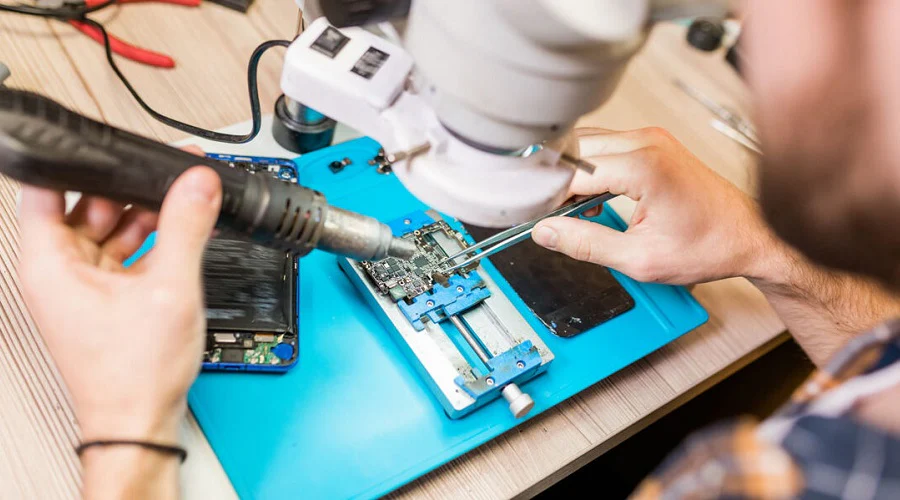If you’ve ever opened a mobile phone to fix a tiny IC chip, replace a charging port, or repair a damaged motherboard track, you already know—these parts are incredibly small. A slight mistake can damage the phone even more. That’s where a mini microscope for mobile repairing becomes your best friend.
Think of it like this:
A surgeon won’t operate without proper lighting and magnification. Similarly, a mobile repair technician shouldn’t work without the right magnifying tool. Whether you’re a beginner or a pro, precision is everything in mobile repairing.
At Vaishno Mobile, we’ve trained hundreds of students in Delhi who upgraded their repair skills instantly after learning to work with a mini microscope. In this guide, we’ll explore:
-
Why this tool is essential
-
How it improves accuracy
-
The different types available
-
Mistakes to avoid when buying one
-
How you can master its use to increase your income
Why Precision is Non-Negotiable in Mobile Repair
Mobile devices are getting thinner, more complex, and packed with micro-components. Repairing them without a magnifying tool is like reading a newspaper in the dark—you might think you see everything, but you’re missing crucial details.
Common challenges without a microscope:
-
Misaligned soldering on microchips
-
Missing hairline cracks in circuits
-
Difficulty identifying damaged PCB tracks
-
Higher chance of repeat repairs and unhappy customers
If you want to build a reputation as a skilled mobile repair technician, accuracy is your selling point.
What is a Mini Microscope for Mobile Repairing?
A mini microscope is a compact magnification device designed for technicians to inspect and repair tiny components on a mobile phone’s PCB. Unlike bulky lab microscopes, mini microscopes are affordable, portable, and perfect for day-to-day repair work.
Key Features You’ll Love:
-
Magnification from 20x to 200x
-
Adjustable LED lighting
-
Portable and lightweight
-
Compatible with mobile repair workbenches
How a Mini Microscope Improves Your Repair Accuracy
Here’s where the magic happens. A mini microscope helps you see what your naked eyes can’t.
1. Identifying Hidden Damage
Sometimes, water damage leaves tiny corrosion spots invisible to the eye. With magnification, you can catch these before they cause more issues.
2. Accurate Soldering
Soldering a BGA chip or replacing a resistor becomes far easier when you can see each pad clearly.
3. Preventing Costly Mistakes
Repairing without visibility means guessing—and guessing can damage components worth thousands of rupees.
4. Faster Turnaround Time
Instead of redoing a repair multiple times, you get it right the first time, increasing customer satisfaction.
Types of Mini Microscopes for Mobile Repairing
Before buying, you should know the different options available.
| Type | Best For | Price Range | Pros | Cons |
|---|---|---|---|---|
| USB Digital Microscope | Beginners & online learners | ₹1,500–₹3,500 | Easy to connect to a laptop, record work | Needs computer to view |
| Handheld Mini Microscope | Quick inspections | ₹800–₹1,500 | Lightweight, portable | Lower magnification |
| Stereo Mini Microscope | Professional-level repairs | ₹5,000–₹15,000 | 3D view, best for soldering | Expensive, less portable |
| Clip-On Smartphone Microscope | Hobbyists or budget repairs | ₹300–₹800 | Cheap, easy to use with phone camera | Not ideal for professional repairs |
Mistakes to Avoid When Buying a Mini Microscope
Many beginners waste money buying the wrong tool. Avoid these mistakes:
-
Choosing a low magnification (less than 20x) for PCB work
-
Ignoring LED lighting (essential for visibility)
-
Buying from non-reputed sellers with no warranty
-
Thinking cheaper is better—quality matters for accuracy
How to Use a Mini Microscope Like a Pro
Even the best tool is useless if you don’t know how to use it correctly.
Step-by-Step Process:
-
Set up proper lighting—avoid shadows on the work area.
-
Adjust magnification depending on the task (20x for inspection, 50x–100x for soldering).
-
Stabilize the PCB—use a repair holder to prevent movement.
-
Keep the lens clean for a sharp view.
-
Practice daily—the more you use it, the faster you’ll work.
Story from Our Training Batch
A student named Rakesh joined Vaishno Mobile’s mobile repairing course in Delhi last year. He had basic soldering skills but often returned customer devices due to missed defects. After two weeks of microscope training, his accuracy improved so much that he started handling complex motherboard repairs confidently—and doubled his monthly income.
Why Every Mobile Repairing Student Should Learn Microscope Skills
-
Higher Accuracy → Happier clients, more referrals
-
Ability to Take High-Paying Jobs → BGA, IC replacement, track repairs
-
Professional Reputation → Stand out from local competition
-
Better Job Opportunities → Service centers prefer skilled technicians
FAQs About Mini Microscope for Mobile Repairing
Q1: Can I repair without a microscope?
Yes, but for complex PCB work, your success rate will be lower.
Q2: What magnification is best?
20x–100x is ideal for mobile repairs.
Q3: Is it difficult to learn microscope work?
Not if you get guided training—our students master it within days.
Q4: Can I use a regular lab microscope?
Technically yes, but mini microscopes are designed for mobile repair ergonomics.
Conclusion & Call-to-Action
A mini microscope for mobile repairing isn’t just a gadget—it’s a game-changer for your career. It can help you see hidden faults, solder with precision, and work faster without errors.
If you’re serious about becoming a professional mobile repair technician, learning how to use this tool is essential. At Vaishno Mobile, we teach hands-on microscope training as part of our Mobile Repairing Course in Delhi, so you can start repairing with confidence from day one.


Leave a Reply